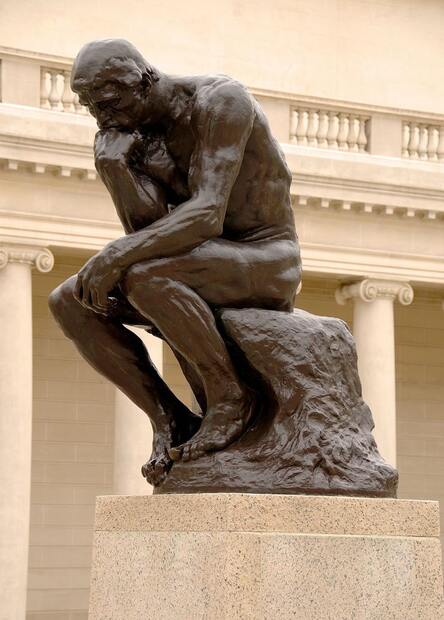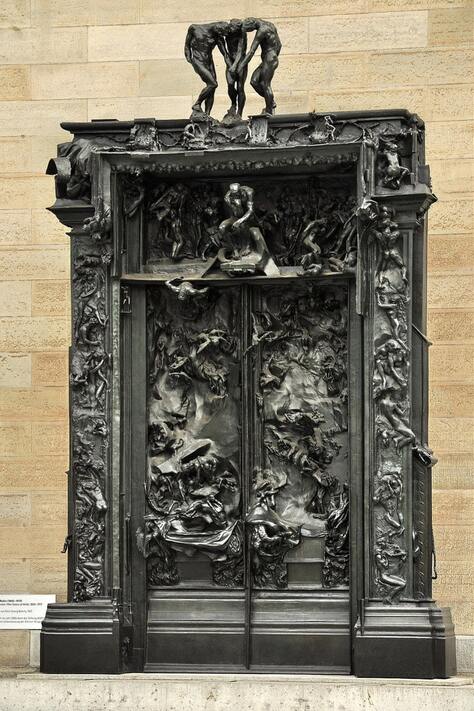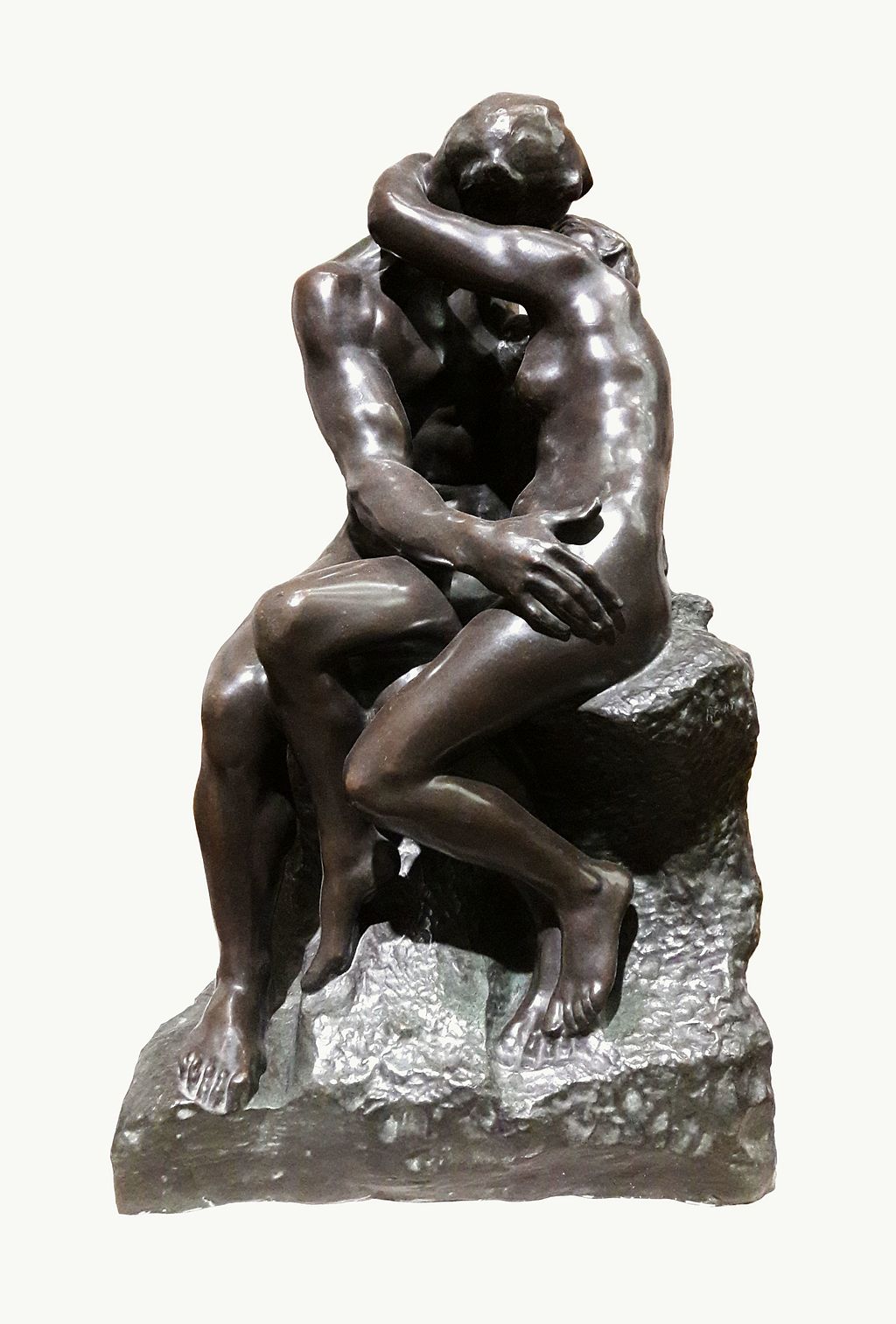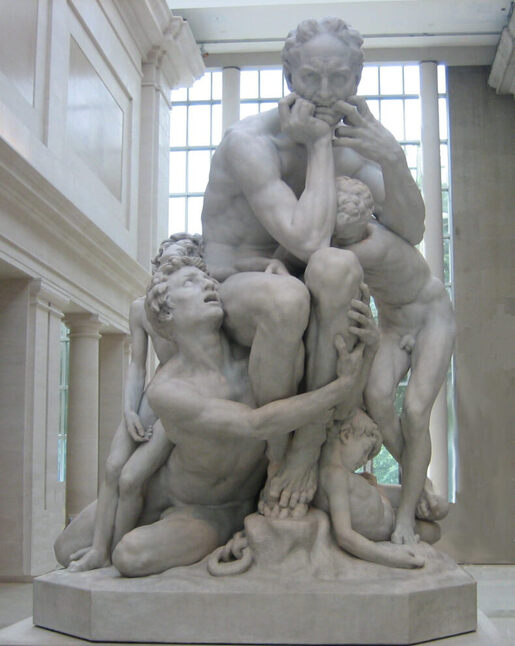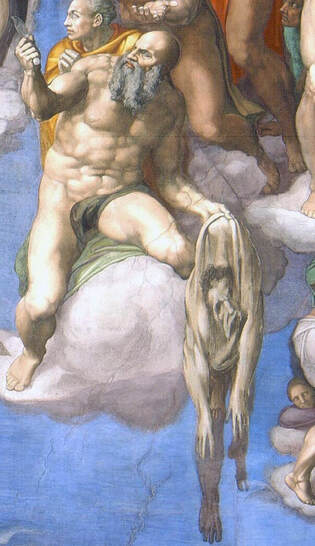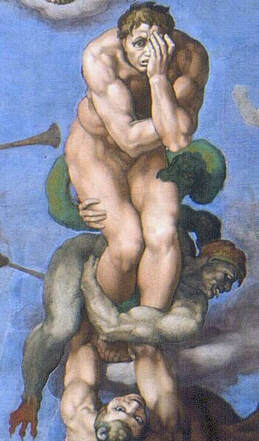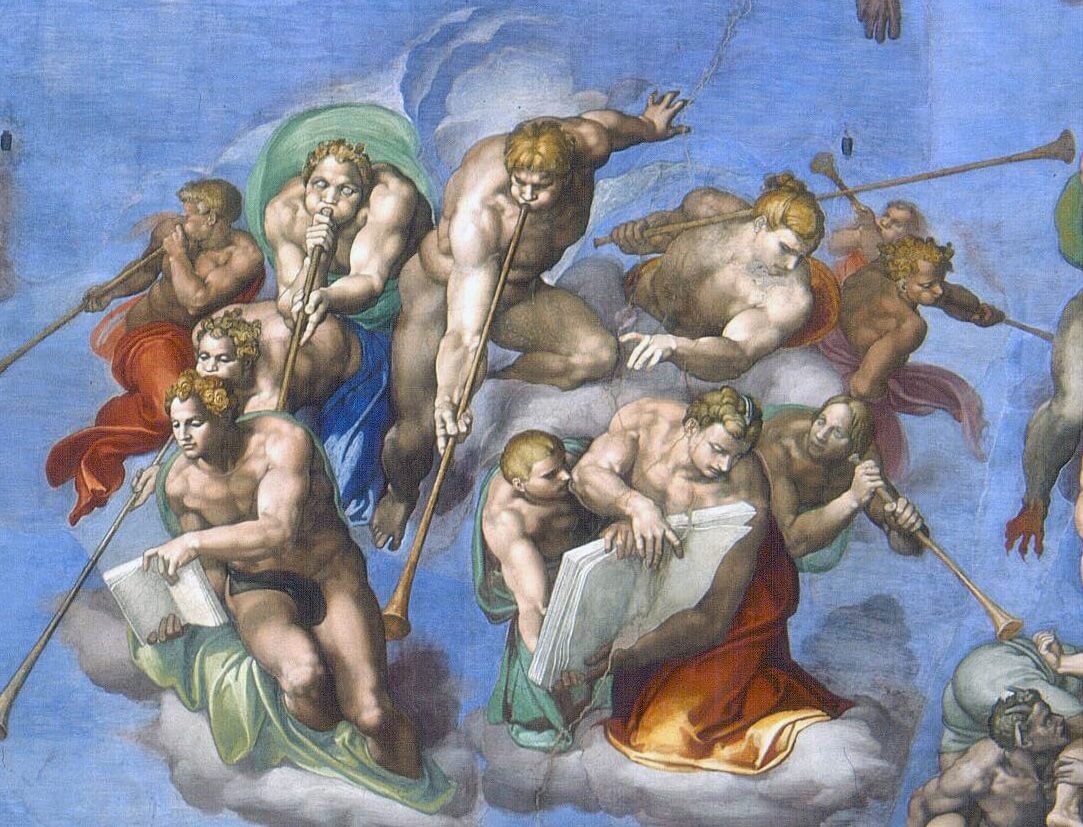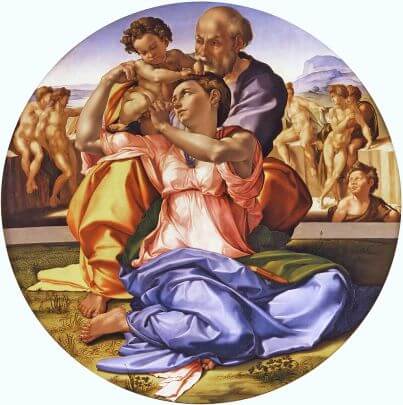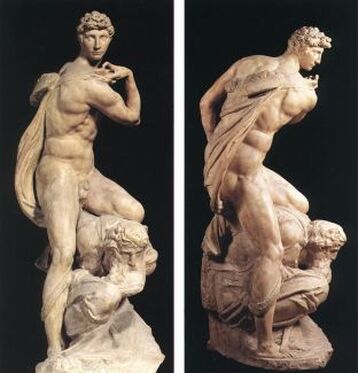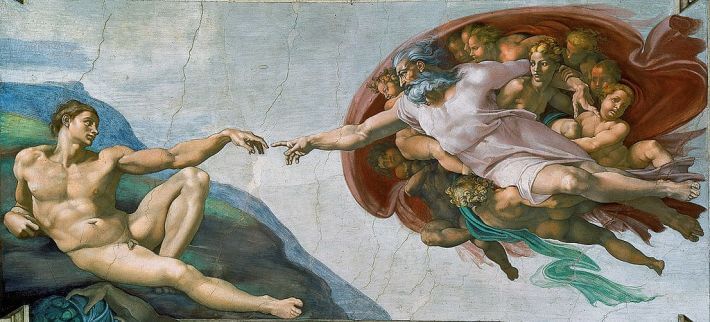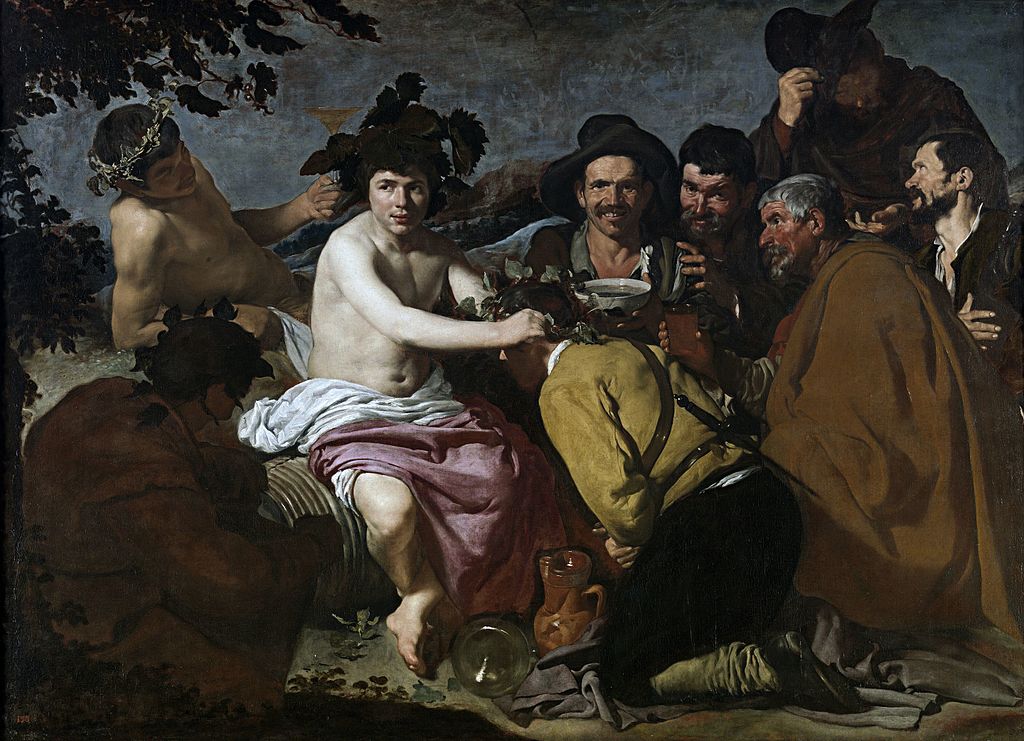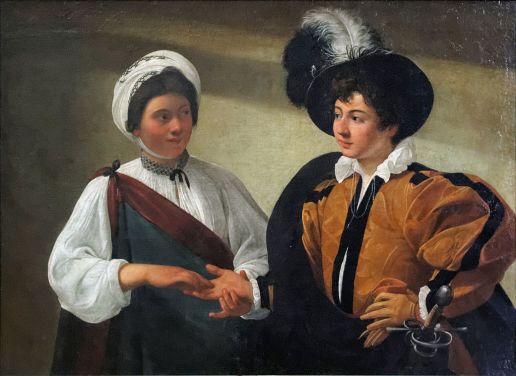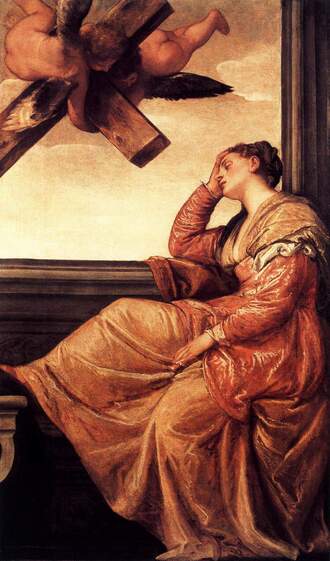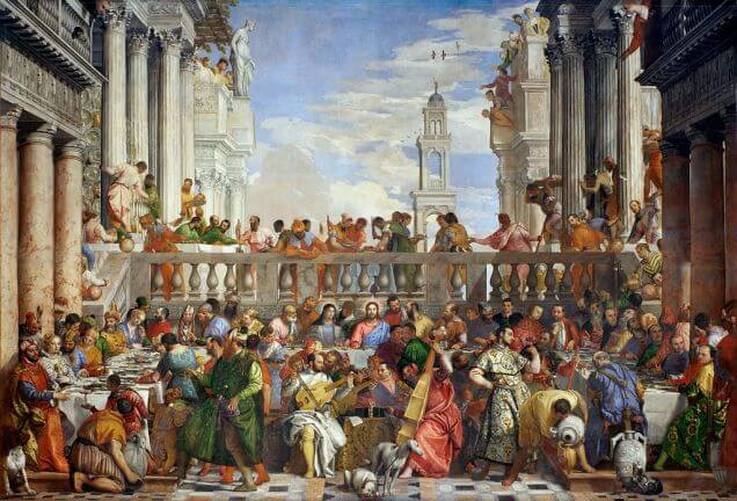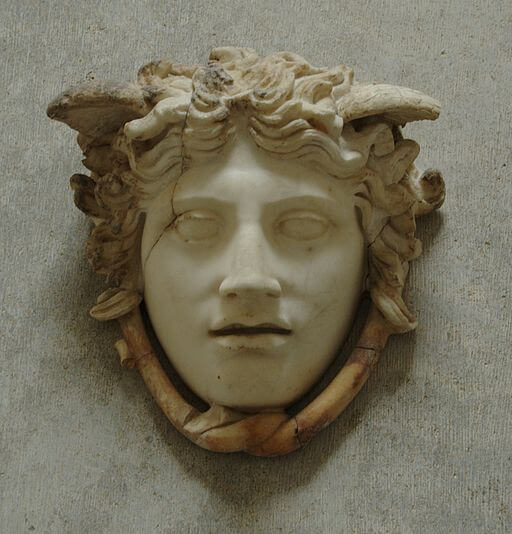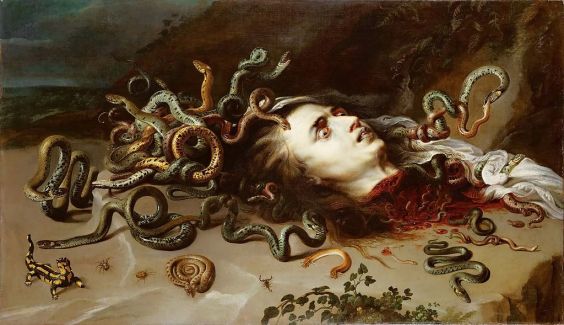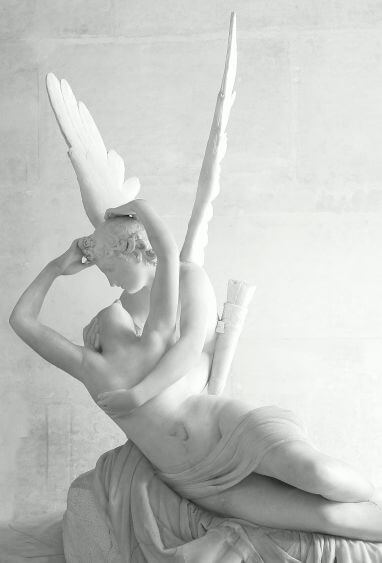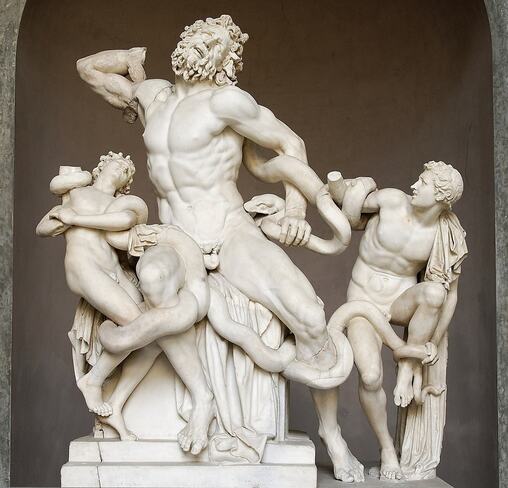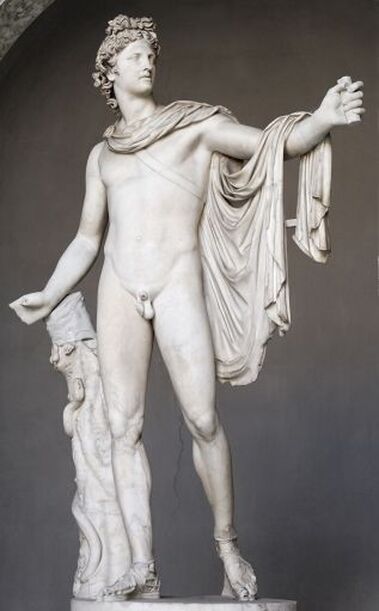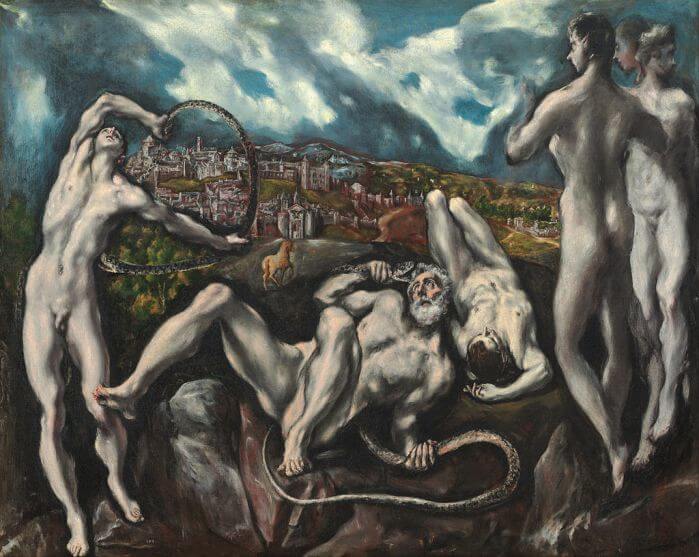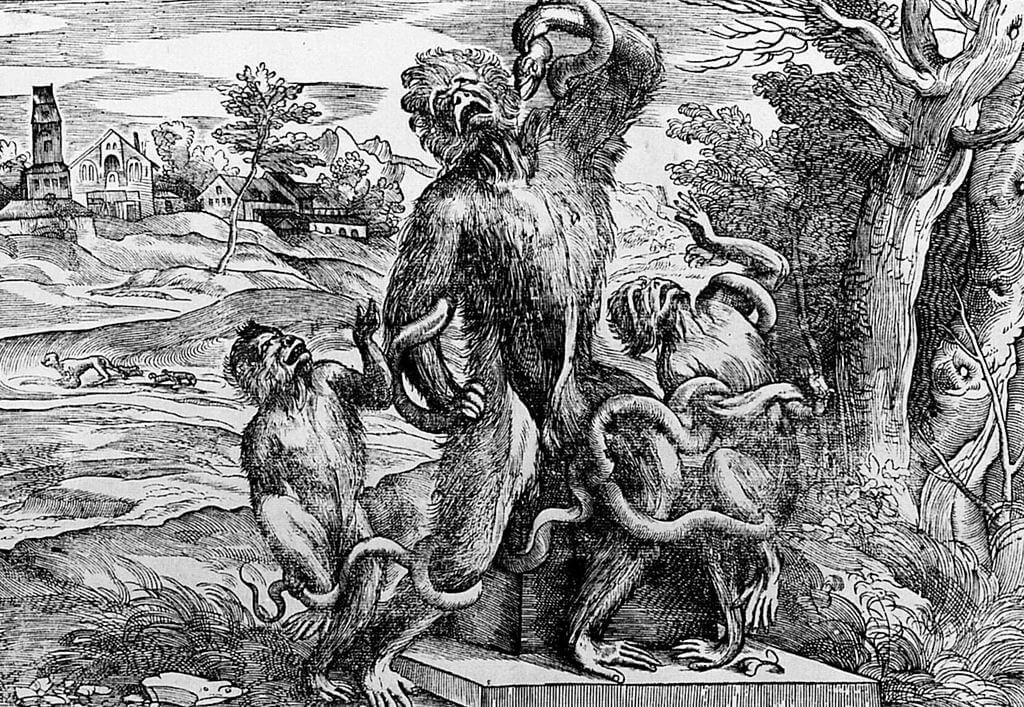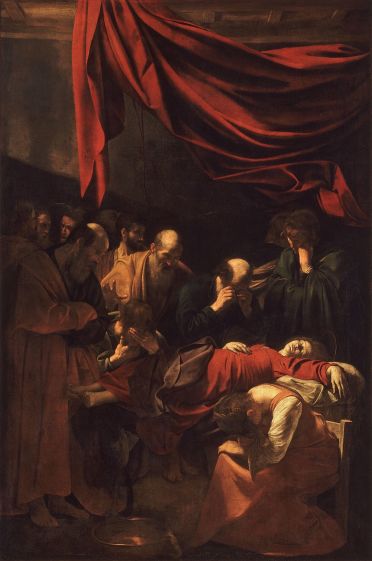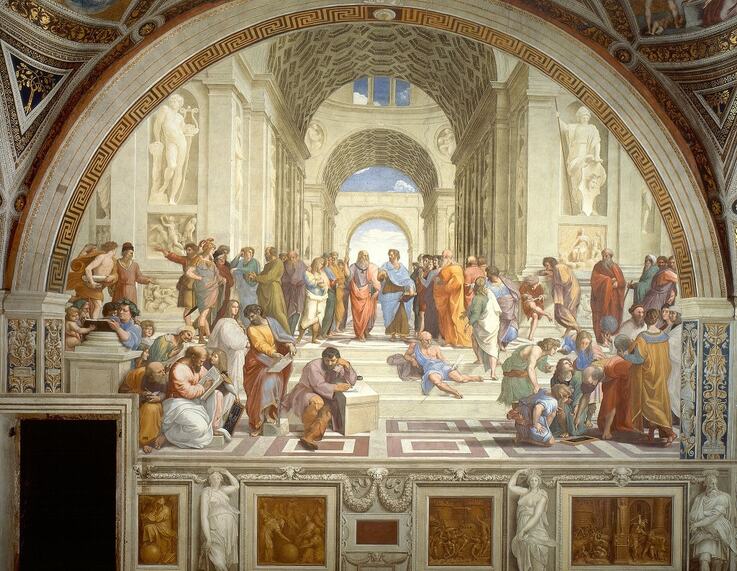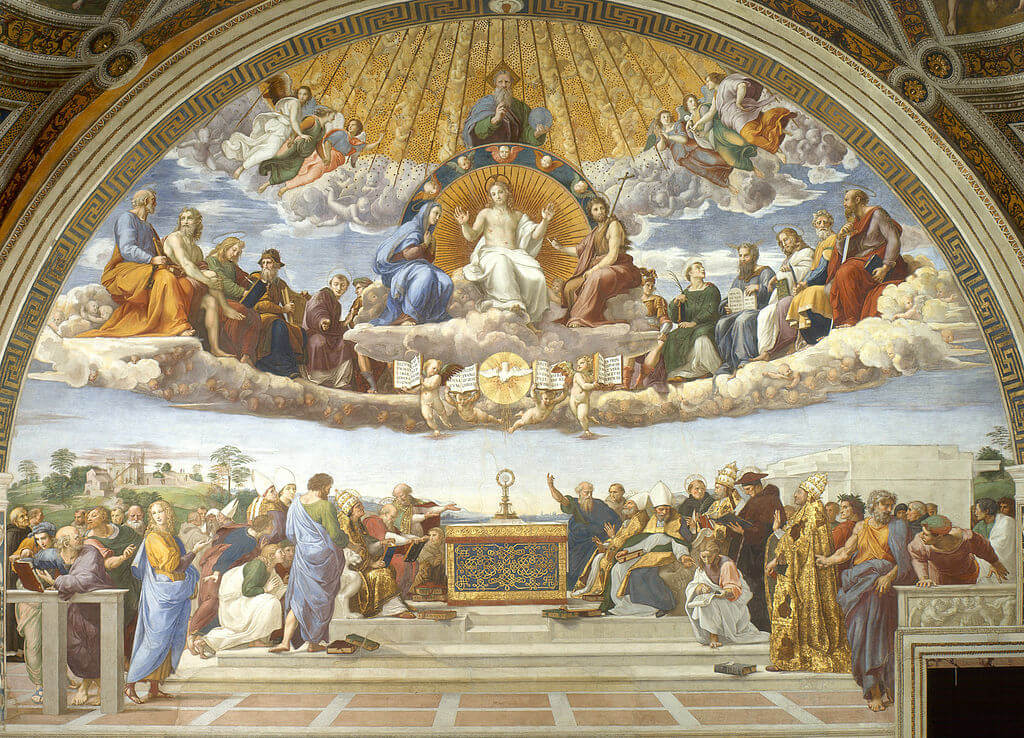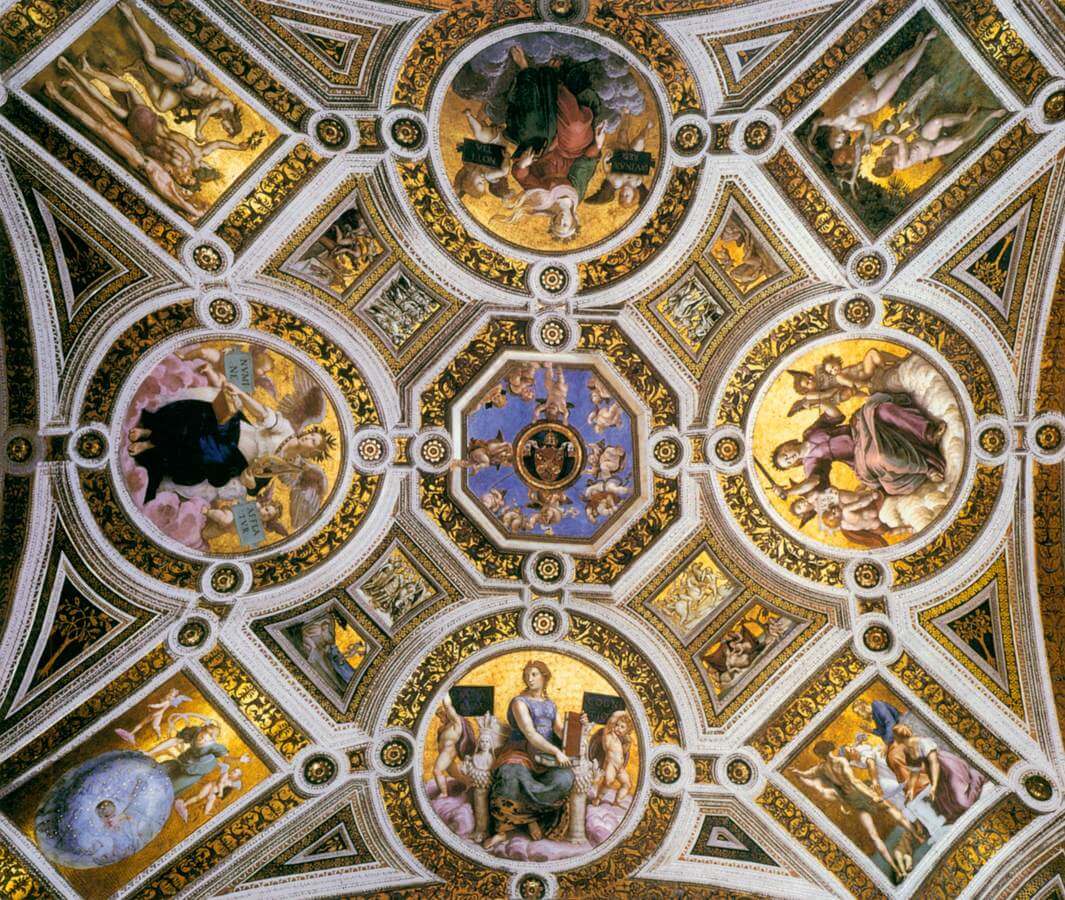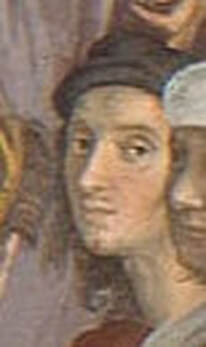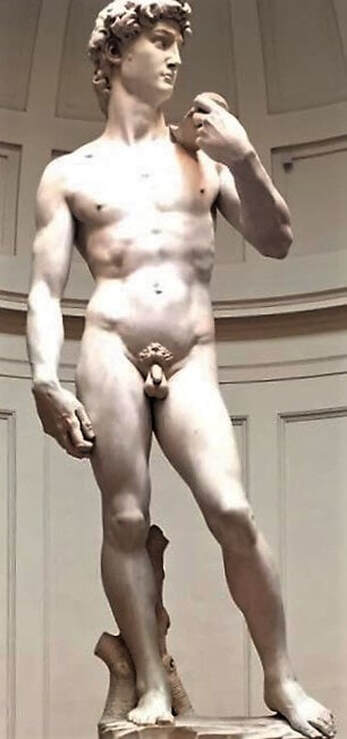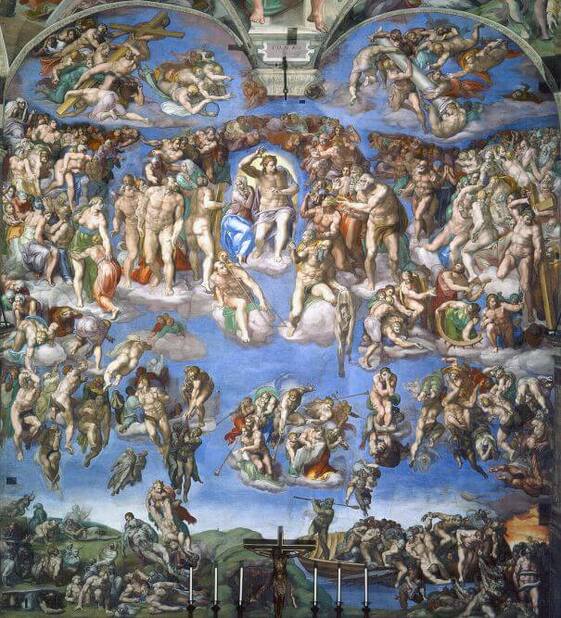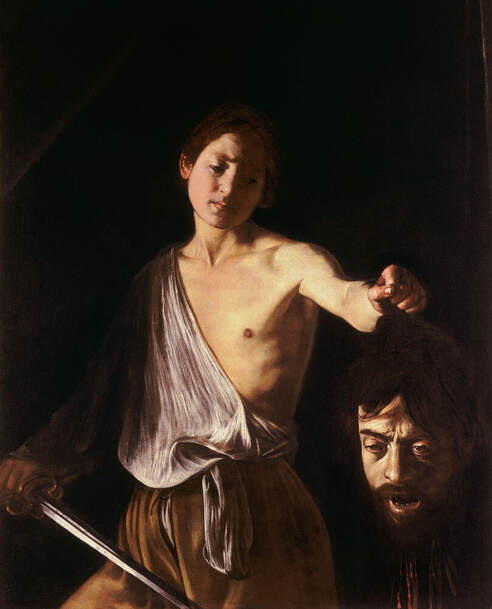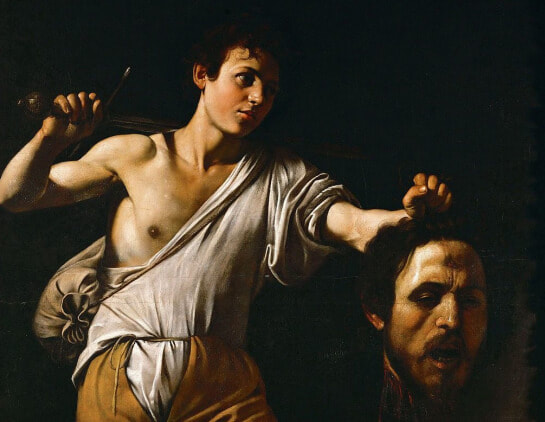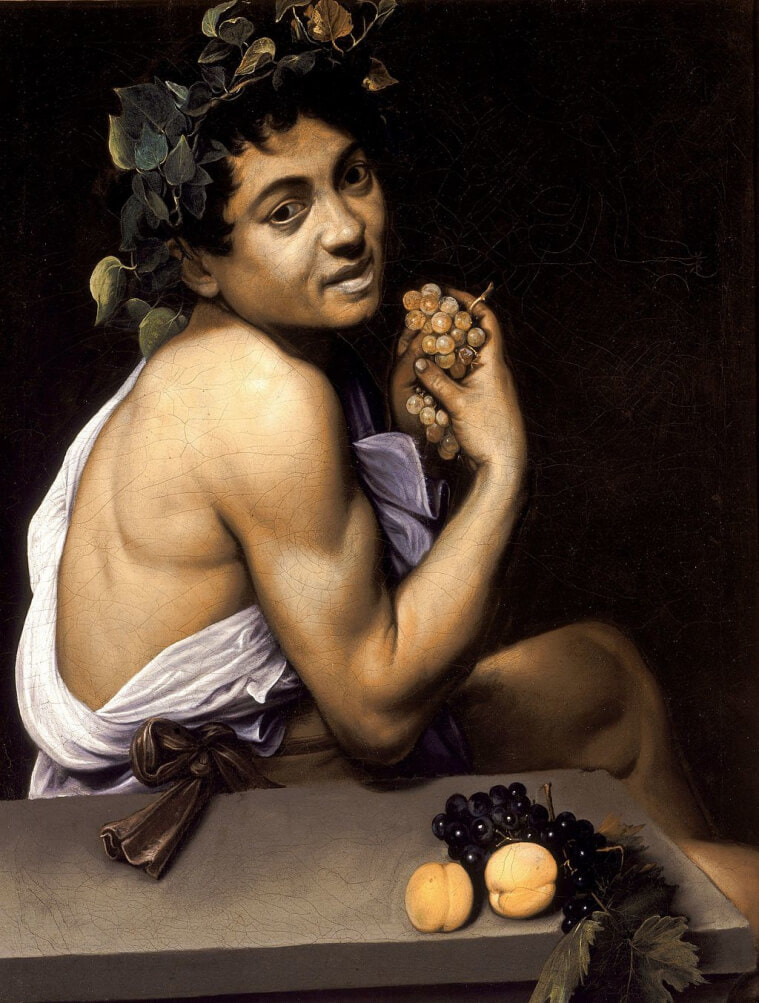|
Where?
When? Rodin created the original sculpture in 1881. He created the first monumental-size sculpture in 1903 and after this many casts of the sculpture have been created, even after his death in 1917. What do you see? A sculpture of a muscular, naked man sitting on a rock. The man is in deep thought and uses his whole body to think. His head is bent forward and leans on his right hand. His wrinkled face, knitted eyebrows, swollen nostrils, compressed lips, and absent-minded gaze reinforce the idea that the man is deep in his thoughts and is completely unaware of the world around him. The man is struggling with his thoughts with every part of his body. Almost no part of his body is relaxed. Most muscles are tense, which is clear by looking at the clenched fist, the arched back, the legs below his body, and the squeezed toes. The statue is over six feet tall making the figure larger than life. It was the intention of Rodin to put the independent sculpture on top of a pedestal such that it would make a colossal impression on the viewers. Backstory: In 1880, Rodin received a large commission from the Directorate of Fine Arts in France to create the entrance doors for a new museum that was to be built (but never opened in the end). He was given the freedom to choose his own theme and decided on creating a scene from Dante’s book Inferno. Rodin was supposed to finish the project in five years but continued to work on the project for 37 years until his death in 1917. The doors – named The Gates of Hell – would eventually include a total of 180 different figures, and they would form the basis for many of Rodin’s most famous statues. Rodin originally created all figures in plaster, and the doors were then to be cast in bronze. The central and the most important part Rodin created for these doors was the statue of The Thinker (Le Penseur in French) who sits right above the two doors with all the characters from the Inferno behind him. The statue was about 27 inches (70 cm) high.
Multiple versions: The statue of The Thinker can be found all around the world. Rodin created the first version of this statue in plaster in 1881. In 1903, he completed the first monumental-size version of this statue. He considered it to be a remarkable piece and wrote to the client of his first bronze casting that he would ensure that only a few copies of the statue would ever be made. However, he did not keep his word.
During Rodin’s life, already more than 20 versions of The Thinker were produced. And after his death, the right for reproduction was turned over to the Republic of France. Nowadays, more than 70 bronze and plaster versions exist and are on display in Asia, Australia, Europe, North America, and South America. Interpretation: There are various interpretations of what and who The Thinker represents. When initially creating this statue as part of The Gates of Hell, Rodin meant the figure to represent Dante pondering about the fate of the damned people entering through the Gates of Hell. This interpretation is based on Dante’s book Inferno, the first part of his trilogy known as The Divine Comedy. When Rodin started to create independent versions, he started to consider different interpretations. Overall, he considered the statue to represent the struggle of the human mind. But he also started to see hope in it. The thoughts slowly become clear, and the man turns from a thinker, into a dreamer, and finally into a creator. Over time, other interpretations have also been given. Some consider the statue to represent Rodin himself. Others interpret the figure as Adam contemplating the sin he committed in Paradise. Who is Rodin? François Auguste René Rodin was born in 1840 in Paris, where he died 77 years later in 1917. He was rejected three times by the leading art school in Paris, the École des Beaux-Arts. It forced him to educate himself differently and this has contributed to his unique style. He was inspired by some of the great Renaissance sculptors like Donatello and Michelangelo. Most of Rodin's famous sculptures were originally intended for his commission of The Gates of Hell. Over time, he realized that he could turn many elements of The Gates of Hell into separate statues and some of these statues have achieved world fame. Among them are The Three Shades and The Kiss. Many of Rodin’s statues have been cast multiple times in bronze which means that his statues have spread across the world.
Why a bronze statue? Bronze is a combination of different metals. It consists primarily of copper (typically 85-90%) and tin (typically 10-15%), but can also contain minor quantities of other metals or nonmetals. It is an attractive material for sculptors for the following reasons.
Fun fact: While The Thinker is one of the most famous statues in the world, Rodin initially named this statue “the poet.” Later it was renamed based on suggestions by foundry workers that the sculpture was quite similar to a sculpture by Michelangelo on Lorenzo de’ Medici, Duke of Urbino. This sculpture was more popularly known as “Il Penseroso” (The Thinker), and this name was also given to Rodin’s statue. The Thinker also shows some resemblance to Ugolino and His Sons which was created by Jean-Baptiste Carpeaux in the 1860s.
1 Comment
Where? On the west wall of the Sistine Chapel in the Vatican Museums
When? 1536-1541 Commissioned by? Originally Pope Clement VII commissioned Michelangelo to paint a fresco about the resurrection, but after the death of Clement VII, Pope Paul III changed the topic of the fresco into the Last Judgment. What do you see? The painting can be divided into two scenes which are interconnected. On the top half is a scene with Jesus in the middle and on the bottom half is a scene where it is decided whether people go to Heaven or Hell. The scene surrounding Jesus: Jesus is the central figure in the top middle of the fresco. He stands on a cloud against the background of a golden aureole. He raises his right arm to condemn the people on the right of painting to Hell, and he puts his left hand forward to draw the blessed people on the left of the painting towards him. His figure has been modeled after the Apollo Belvedere which is also in the Vatican Museums. Jesus is surrounded in the top half of the painting by all sorts of saints and Biblical figures. While many of these figures cannot be precisely identified, some important ones stand out. To Jesus’ immediate left (from our perspective) is Mary with a red dress and a bright blue cloak. She looks to the blessed people on the left of the painting. She has a passive attitude as her role to intervene between the people who pray to her and God is no longer relevant.
The scene at the bottom: In the bottom left, people arise from their graves. In the scene above this one, some of these people are rising through the help of angels or clouds. These are the people that are saved.
In the bottom middle, above the cross of Jesus, there is a group of wingless angels who are blowing trumpets to awake the dead. They carry two books that contain the names of the people who are going to Heaven and Hell. The bigger book on the right contains the people that go to Hell. On the bottom right, there is a boat full of people who are going to Hell. Charon is standing on the left side of the boat and aggressively forces the people out of the boat. Minos is standing in the right bottom corner of the painting with a snake wrapped around him (and the snake bites his genitals). He is standing in front of the entrance to Hell. Charon and Minos are two figures described in Dante’s poem Inferno, and they are depicted exactly as Dante describes them.
Backstory: Michelangelo initially discussed the content of a large fresco in the Sistine Chapel with Pope Clemente VII in 1533. However, he only started to work on the actual fresco in 1536 under Pope Paul III. Before Michelangelo started his work on The Last Judgment (sometimes spelled The Last Judgement), the wall was covered by three frescos from Perugino.
Michelangelo decided that the wall should be rebuilt using high-quality brick stones and slope slightly inwards such that the wall could not collect dust. The goal of his fresco is to remember viewers of the upcoming day of the Last Judgment, where everyone, including the viewers, will be judged by God on whether they will go to Heaven or Hell. The painting caused quite some controversy when it was revealed. Controversial elements were the inclusion of mythological figures and the wingless angels in the fresco. Another important debate was about all the nudity in the fresco on the wall of a chapel. Originally the genitalia of many people in this fresco were visible. Around 1564, probably right after the death of Michelangelo, Danielle Da Volterra was ordered to cover some of these obscenities in this fresco.
Symbolism:This fresco contains lots of symbolism, and almost every attribute in the painting has a symbolic meaning. Below are a few examples.
The Last Judgment according to the Bible: The Last Judgment of all people who lived on Earth is an important aspect of the Christian religion. It is described as a moment in which all people will come to life again, and the good people will be rewarded by going to Heaven, and the evil people will go to Hell. There is a large number of references in the Bible to the Last Judgment (see here for a complete list). The most important and direct reference is in Revelations 20:11-15 in which the judgment day is described in a vision to John the Apostle. Another good source is Matthew 25: 31-46 in which Jesus explains the Last Judgment as the day when he will return to Earth with all his angels. Several main elements in this fresco can be linked to the Biblical stories. For example, the scene at the bottom left on the opening of the graves is based on Ezekiel 37:1-14. However, many aspects of this painting also differ from the Biblical description. Moreover, some elements are also inspired by non-Biblical sources, such as Dante’s Inferno. Who is Michelangelo? Michelangelo di Lodovico Buonarroti Simoni (1475-1564) was born in Caprese in the Republic of Florence. He lived most of his adult life in either Florence or Rome. From 1534 till his death he lived in Rome where he not only worked on this fresco in the Sistine Chapel, but he was also appointed lead architect of St. Peter’s Basilica. Michelangelo was an architect, painter, poet, and sculptor and he is remembered most for his paintings and sculptures. Only a few paintings of him have survived, including the Doni Tondo in the Uffizi Museum. However, he is better known for his amazing frescos such as the ceiling of the Sistine Chapel which includes the famous scene of The Creation of Adam. His sculptures are also considered to be among the best in the world. A couple of examples are his statue of David in the Galleria dell’Accademia and his Genius of Victory in the Palazzo Vecchio.
Fun fact: Michelangelo included about 400 figures in this fresco and has included these people in a large number of different positions. This required very extensive knowledge of the human body which is something Michelangelo possessed.
From a young age, Michelangelo participated in the dissection of the bodies of convicted criminals, something that the Pope allowed. The only condition was that the bodies of the criminals would be properly buried afterward. These dissections provided Michelangelo with very valuable knowledge of the human body, which was important for the realism of his sculptures and paintings. Michelangelo was not the only artists that dissected dead bodies. Multiple artists did this during that period, including Leonardo da Vinci, as the art moved away from unrealistic religious painting during the Middle Ages to more realistic and idealized human bodies during the Renaissance. Interested in a copy for yourself? Poster
Where? Room VIII of the Galleria Borghese
When? 1593-1594 Commissioned by? Unknown; Caravaggio probably used this painting to market himself for commissions. What do you see? A self-portrait of Caravaggio. He poses as the Roman god Bacchus, the god of grape harvest, wine, and intoxication. He is half-naked, wearing a white robe, and the ribbon around his robe lies on the table. We can see his muscular shoulder and arm. However, Bacchus does not look healthy. His skin is yellow and the white part of his eyes as well. Also, he has bluish lips. He wears a crown of ivy leaves on his head. He folds his hands and holds a bunch of white/yellow grapes between them. Bacchus sits at a stone table with on top a bunch of healthy black grapes, two peaches which have a similar color as Bacchus’ skin, and some vine leaves. Backstory: This painting is also known as ‘Sick Bacchus’ or ‘Self-Portrait as Bacchus.’ Caravaggio used a mirror to paint this work as he did more often later in his career. He probably painted it between 1593 and 1594. In 1607, the painting was confiscated by the Pope because of tax evasion by its owner, Giuseppe Cesari. The Pope gave the painting to his nephew, Scipione Caffarelli-Borghese. The painting was still reported to be in the Borghese collection in 1693. As the painting does not have a signature of Caravaggio, over the next centuries, it was attributed to several other painters. In 1927, it was attributed to Caravaggio again, and the large majority of people believes that this is a real Caravaggio. Who is Bacchus? Known in Greek mythology as Dionysus, Bacchus was the son of Zeus and Semele. He was the god of ecstasy, fertility, grape harvest, wine, and winemaking. He was a popular subject for artists as it allowed them to depict earthly pleasures. Around 1595, Caravaggio painted another painting of Bacchus which is in the Uffizi Museum. In contrast to his first painting, Bacchus looks quite healthy in that painting. Another example of an artist who has used Bacchus as the subject of his art is Diego Velázquez. He painted The Triumph of Bacchus in the Prado Museum.
Symbolism: The crown of ivy leaves is a symbol of Bacchus. Ivy was a sacred plant for Bacchus as it was thought to possess the power of preventing intoxication. The bunch of grapes also contains some rotten grapes. This is a symbol of death which is always looming and must have been in the mind of Caravaggio when he was in the hospital for a long time before he created this painting. At the same time, he holds the bunch of grapes close to his mouth suggesting that he is available for some intimacy. This suggestion is also emphasized by the ribbon of his robe, which is explicitly shown on the table and is ready to be opened. Moreover, the two peaches on the table symbolize a desire to be together with someone else.
Who is Caravaggio? Michelangelo Merisi Caravaggio (1571-1610) was born in Caravaggio near Milan, Italy. In 1592, he fled to Rome due to some trouble with the police. He arrived in Rome with almost no money and no place to live. Moreover, he got seriously ill and spent six months in the hospital. Luckily, he was a very talented painter. During his recovery, he painted Young Sick Bacchus. At the beginning of his career, he focused on naturally and realistically depicting human subjects and other elements in his paintings. This was very uncommon and makes the work of Caravaggio unique. To emphasize the imperfections of life, Caravaggio would get the models for his paintings from the streets (like beggars and prostitutes) and would buy some fruit on the market, accepting the fact that the fruit did not look perfect. Early in his career, Caravaggio also painted The Fortune Teller in the Louvre and the Capitoline Museums, and The Musicians in the Metropolitan Museum of Art.
Fun fact: Caravaggio was recovering from a serious illness when he painted this work. There are several theories on why he was in the hospital, ranging from a serious kick of a horse to malaria. However, during his recovery, there were still signs of sickness as we can see in this painting. He has jaundice, which leads to a yellowing of the skin and the white part of your eyes. It makes sense that Caravaggio used himself as the model for this painting. He was very poor in the beginning of his career (and also not rich during the rest of his life), and Caravaggio himself was the cheapest model he could find for this painting.
Interested in a copy for yourself? Poster or canvas.
Where? Room 10 of the Pinacoteca in the Vatican Museums
When? Around 1580 Commissioned by? Unknown What do you see? Saint Helena has a vision of the location of the True Cross (the cross on which Jesus was crucified on Golgotha). Helena is peacefully dreaming about the wooden cross of Jesus which is held in this painting by the winged cherub on the right. The naked cherub stands with his back toward the viewer. Helena sits on a chair within a palace-like building (indicated by the two big columns, the gold statue in between them, and the large patterned curtain behind her). She has her eyes closed and supports her head with her left hand. Helena wears an expensive 16th-century silk dress with beautifully-painted folds. On top of the dress is a red cloak which is fastened by a big golden brooch. In the middle of the brooch is a carved image of a cupid. She has a transparent veil on her head and a crown filled with jewels on top of it, indicating that she is the Empress of the Roman Empire (as she was the mother of Emperor Constantine). Backstory: This painting is also referred to as Vision of St. Helen. In 1565, Veronese painted another version of The Vision of Saint Helena (also called The Dream of Saint Helena). That painting has the same theme as the current painting and is in the National Gallery in London. The style of both versions differs substantially, which is a testament to the versatility of Veronese’s painting style.
Who is Saint Helena? She was born in 250 AD, probably in a low-standing family. She became the partner of Constantius Chlorus who would become the Roman Emperor in 293. However, Constantius divorced her in 289 to find a wife with a status that would better match his future role as the Emperor. Before the divorce, they got a child, Constantine. He would become Emperor Constantine (272-337 AD), also known as Constantine the Great.
Helena is known for the big influence she had on her son. She was an important reason that Constantine became the first Christian Emperor and he subsequently promoted Christianity throughout the Roman Empire. During a trip to Jerusalem, she allegedly discovered the True Cross. What is the True Cross? The cross on which Jesus was crucified. After the crucifixion, the cross of Jesus and the crosses of the two people who were crucified with him got lost. There are several accounts of how Saint Helena discovered the cross, and they all differ from each other. According to some, in 326-328, Saint Helena traveled to Palestine, and she found the three crosses in Jerusalem. One of the crosses carried the name of Jesus. However, real evidence came when a miracle occurred. A very sick woman arrived at the crosses. She touched the first two crosses and nothing happened, but when she touched the cross of Jesus, she got cured immediately. Nowadays, many Catholic and Orthodox churches claim to have a small fragment of the True Cross. Who is Veronese? Paolo Caliari (1528-1588) was born in Verona which explains that he is better known under the name Paolo Veronese. He spent most of his adult life in Venice. He is considered to be one of the three masters of the Venetian School of Painting, together with Tintoretto and Titian. Veronese usually created colorful paintings, full of drama, often with beautiful architectural elements. The people in his paintings are often painted quite realistically, elegant, and dressed in luxurious clothes. Veronese is most famous for some of his larger paintings, such as The Wedding at Cana in the Louvre and The Feast in the House of Levi in the Gallerie dell’Accademia in Venice.
Fun fact: This painting shows a calm and peaceful scene. However, most of the work by Veronese shows a considerable amount of drama. One typical aspect of Veronese’s style that is present is the use of vibrant colors, especially for the clothes of Saint Helena. The dress mainly contains gold, blue, and white and the large folds of the dress and the way the light falls on it, really make it stand out. The combination with the red cloak makes this a very warm, yet vibrant, painting. The clothes of Saint Helena seem to confirm the claim by the French poet Gautier that Veronese was the greatest colorist who ever lived.
What do you see? This marble statue shows the Greek demigod Perseus holding the head of Medusa. Perseus is standing in a triumphant pose as he has just beheaded Medusa. He holds the head of Medusa in his left hand by grabbing the venomous snakes on her head. The face of Medusa expresses horror as it has just been cut off. However, you can also still see the beauty of her face.
Interestingly, Perseus is looking at her face, even though that should turn him into stone according to the myth (but the irony may be that this actually happened in this statue). Perseus is wearing the sandals of the Roman messenger god Mercury (Hermes in Greek) which allowed Perseus to fly. These sandals were made of gold by the god Vulcan (Hephaestus in Greek). Perseus also wears the cap of Hades, which could make him invisible. In his right hand, Perseus is holding a harpe sword, which is a sword with a sickle-like extension on one side of the blade. The sword was owned by Zeus, the father of Perseus. A robe hangs loosely over his arm. Notice that his left foot is standing in the front, while the heel of his right foot is lifted. In this way, Canova creates the sense that Perseus is moving forward.
Backstory: Antonio Canova made this statue twice. The first version is on display in the Vatican Museums and is also known as Perseus Triumphant. A replica by Canova is in the Metropolitan Museum of Art. The head of Medusa in this statue has been inspired by the Medusa Rondanini, a marble sculpture that is in the Glyptothek in Munich.
The rest of the statue has been heavily inspired by the Apollo Belvedere, a famous statue from antiquity, which is also in the Octagonal Court of the Vatican Museums. The first version of the statue of Perseus and Medusa was acquired by Pope Pius VII to replace the Apollo Belvedere which Napoleon Bonaparte had confiscated and shipped to the Louvre in Paris. When the Apollo Belvedere returned to Rome, they kept the statue of Canova as it was such a great piece of work. When the second version of this statue first arrived at the Metropolitan Museum of Art, the sword was missing. They took a cast from the version in the Vatican Museums and added a newly carved marble sword to the statue.
The story of Perseus and Medusa: In Greek mythology, Perseus is the son of Jupiter (Zeus in Greek), who was the king of the gods, and Danaë. Polydectes, the King of Seriphos, ordered Perseus to provide him with the head of Medusa as a wedding gift for him.
Medusa was one of three sisters (Stheno, Euryale, and Medusa) who were often referred to as Gorgons. Both Stheno and Euryale were immortal, but Medusa was not. According to the Roman poet Ovid, Medusa was a beautiful young woman. However, after Poseidon (the god of the sea) made love to her in Athena’s temple, Athena (the goddess of wisdom and war) changed her beautiful locks into living, venomous snakes (in other mythological stories the three sisters were already born with snakes on their heads). Medusa had a horrific facial expression that could turn people (or according to some, only men) who looked at her into stone. Perseus used a shiny shield that he got from Athena to avoid looking at Medusa directly and succeeded to cut off her head. When Perseus returned to King Polydectes, he showed him the head of Medusa, which still retained its power, which turned Polydectes into stone. This was the purpose of Perseus as he discovered that Polydectes had abused his mother. Perseus and Medusa in art? Perseus and Medusa have been a popular subject in art. Famous artists have used their story as the inspiration for their artwork. Leonardo da Vinci created two version of the head of Medusa, but neither of them has survived. Caravaggio has painted the head of Medusa on a shield which is in the Uffizi Museum. Rubens also created two versions of the Head of Medusa, of which one is in the Kunsthistorisches Museum in Vienna. Various sculptures of Perseus and Medusa have also been made, such as one by Benvenuto Cellini.
What is neoclassicism? Around 1760, neoclassicism started in Rome in opposition to the then-popular Baroque and Rococo styles. The neoclassic style quickly spread through Europe and become especially popular in France, with artists such as Jacques-Louis David and Jean-Auguste-Dominique Ingres.
Neoclassic art is inspired by the old Roman and Greek art and focuses on simplicity and symmetry. The paintings, sculptures, and architecture in this style did not show much emotion, were more ordered and down-to-earth compared to the Baroque style and were less playful compared to the Rococo style. Fun fact: When making a statue of marble, the artist needs to be aware of the center of gravity. In this sculpture, the stretched arm of Perseus and the head of Medusa naturally shift the center of gravity. Canova included two tricks to keep the sculpture stable and decrease the chances that it gets severely damaged by movement or that the head would simply break off.
Where? The Octagonal Court of the Museo Pio Clementino in the Vatican Museums
When? Uncertain, but estimates range from the 3rd century BC to the 1st century AD. By who? Unclear, but probably this is a Roman copy of an ancient Greek original in bronze. Some people suggest that it was made by the three Greek sculptors Hagesander, Athenodoros, and Polydorus. What do you see? This life-size statue is made of seven different blocks of marble and shows Laocoön and his two sons, Antiphantes and Thymbraeus, being attacked by two sea serpents. Laocoön sits on an altar and is sculpted as a very muscular man. He strains every muscle that he has to escape from the serpents. The oldest son on the right seems to break free from the serpents and looks at his brother and father. Laocoön and the youngest son on the left are in big trouble, and their faces express their struggle. The youngest son seems to cast a last glance at his father, but he looks to be (almost) dead already. Notice that the serpents are trying to kill Laocoön and his sons both by constricting and biting them. You can see the head of one of the serpents next to the left hand of Laocoön. You can also see that a few pieces are missing from this sculpture.
Who is Laocoön? According to Greek mythology, Laocoön was a Trojan priest. There are various accounts of his story. Virgil describes the most popular version in the second book of the Aeneid. According to him, when the Greeks left Troy, they left as a gift a very large wooden horse in front of the gates of Troy. Laocoön suspected that this horse was a trick of the Greeks and tried to convince the people of Troy not to accept the gift.
To prove that the horse was a trick, Laocoön struck the horse with his spear to show that it was hollow. Poseidon and Athena then punished him for his interference and Laocoön and his two sons were attacked and killed by two sea serpents named Porces and Chariboea. The Trojans interpreted this event as a sign that the horse was not a trick and they took the horse into their city walls after which the Greek came out of the horse during the night and defeated the Trojans. Copies: Many copies of this statue have been made and can be found across the world. A well-known copy is the marble version by Baccio Bandinelli in the Uffizi Museum in Florence. Another bronze version made by Francesco Primaticcio for King François I of France is in the Louvre. Jean Baptiste Tuby made a copy for the Park of the Château de Versailles in France. The Hermitage Museum in Saint Petersburg, Russia, has a terracotta version of this sculpture by Stefano Maderno. Some other places that have a copy of this statue are the Mannheim Palace in Germany, the Archeological Museum of Odessa in Ukraine, Houghton Hall in England, and the Palace of the Grand Master of the Knights of Rhodes in Greece. This statue has also inspired many other artists to depict the story of Laocoön. For example, El Greco created a painting of Laocoön that is now in the National Gallery of Art in Washington, DC. Several parodies of this sculpture have also been made over time. For example, Niccolò Boldrini made a woodcut around 1540 for which he copied a drawing of Titian in which monkeys replace Laocoön and his sons.
Fun fact: The statue misses a few limbs and parts of the serpents. Over time, the missing parts were added to the sculpture and sculptors, including Antonio Canova did various restorations. The right arm of Laocoön was already added in the 16th century, but there was quite some discussion on whether the arm would be straight up or bent back over the shoulder (which Michelangelo suggested). The experts chose that the arm would be straight up and you can see in the picture how the statue looked before 1960.
In 1906, an archeologist found a right arm of a sculpture which he thought could be the missing right arm of the Laocoön sculpture. He donated the arm to the Vatican Museums, but only 54 years later the museum verified that it was indeed the missing arm of Laocoön, and it was added to the sculpture. The missing right arm was bent over the shoulder as Michelangelo supposed (this also means that the replicas of this sculpture from before 1960 are incorrect). In the 1980s all non-original additions to the sculpture were removed, and the sculpture became like we can see it today.
Where? Room 12 of the Pinacoteca in the Vatican Museums
When? 1602-1604 Commissioned by? The Vittrici (or Vittrice) family, probably Gerolamo Vittrici or his son Alessandro Vittrici. What do you see? This painting shows five people in the middle of the night and the lifeless body of Jesus. Notice that the body of Jesus is clean and there is no blood, although you can see a wound in his side. The chest and arm of Jesus are pale indicating that he has died already. The people are standing on top of a big stone at the entrance of the tomb where Jesus would be lowered down and buried. The person on the right in the brown robe is Nicodemus. He is holding the knees of Jesus and looks into the direction where the body of Jesus would be placed. On the other side, a young Saint John, who can be identified by his red cloth, is putting an arm under the shoulders of Jesus. Behind Nicodemus are three women who express their emotions in different ways. One raises her hands in the air (it is not clear which Mary this is), the other is crying and drying her tears (this may be Mary Magdalene), and the third is the old Virgin Mary who is looking sadly at the body of Jesus. Above the head of Jesus, you can see the hand of the Virgin Mary. In the left foreground, you can see a great mullein plant, which is a symbol of driving away evil spirits. Finally, notice that Caravaggio chose for a black background without any landscape or architecture, which makes us focus completely on the figures in the foreground. Backstory: This painting served as an altarpiece in one of the Chapels (the Cappella della Pietà) in the Santa Maria in Vallicella church (also known as the Chiesa Nuova) in Rome. In 1797, this painting was removed from the church by Napoleon, but around 1816 it returned to Rome to hang in the Vatican Museums. Several well-known artists, including Cézanne, Gericault, and Rubens, have used this painting as an example for their own work, often with some modifications. A replica of this painting is in the Chiesa Nuova. A version of Rubens is quite similar to the original by Caravaggio. This painting is now in the National Gallery of Canada. However, there are some differences between the two paintings, such as Saint John already stepping down with one foot into the grave. Another difference is that Rubens has replaced Nicodemus by Joseph of Arimathea.
The Santa Maria in Vallicella church: This church is also called the Chiesa Nuova. It is located in Rome next to the Corso Vittorio Emanuele II. This is the main church for the Oratorians. This is a community of secular priests recognized by the Pope and the members of the community are not bound by vows but bound by a voluntary bond of charity. The church is richly decorated with gold, frescos, paintings, and altarpieces. The church got into serious disrepair during the 19th century, but in 2006 a major restoration was completed. Nowadays, the church is still in active use.
Who is Caravaggio? Michelangelo Merisi da Caravaggio (1571-1610) was born in Milan and grew up in Caravaggio (which is where his name comes from). He was a brilliant painter, but he led a troubled life. After some incidents with the police, he fled Milan in 1592 and moved to Rome. Typical for his work is that he incorporated a realistic depiction of the physical and emotional state of his subjects. He painted a variety of different works, including religious paintings, mythological paintings, still lifes, and self-portraits. Besides the painting on the entombment, Death of the Virgin in the Louvre is another example of a great religious work by Caravaggio. An example of a great mythological painting is his work of Bacchus in the Uffizi Museum.
Fun fact: The painting is quite dark. While this was the intention of Caravaggio and may partly be due to the exposure to light over time, Caravaggio also took the place where the painting would be placed into account when choosing the colors he used for the painting. He considered both how the light would fall on the painting and the height at which the painting would be placed. So, when removing his paintings from their intended location, the quality of his works sometimes seems to be worse than if it would have stayed in its intended place.
To fully appreciate this painting, one should attend the mass in the Chiesa Nuova where a replica of this painting hangs on its original location. The painting hangs about five feet above the altar step, which is at eye-level for the priest when the body of Christ is remembered during the mass. The attendees to the mass would look up to this painting.
Where? Stanza della Segnatura (one of the four Raphael Rooms) in the Vatican Museums
When? Between 1508 and 1511 Commissioned by? Pope Julius II What do you see? 58 different philosophers are gathered on a sunny day in a beautiful palace-like building. The philosophers are busy with a variety of activities such as reading, writing, listening, arguing, explaining, etc. In the center of the fresco, under the arch, you can see two of the most famous philosophers both holding a book: Plato (with the red robe) is on the left and Aristotle (with the blue robe) is on the right. These two philosophers had different philosophical views. Besides them, two rows of philosophers are following their conversation. Several figures to the left of Plato, you can see a figure in a completely green robe. This figure is Socrates. You can see four to five people who are listening to his story. In front of Aristotle, you can see Diogenes, a half-naked man dressed in blue sitting on the stairs. In the right foreground, a group of nine philosophers is busy with geometry and astronomy. Five people are looking at a geometrical problem and Euclid or Archimedes (art historians are not sure who of the two it is) is using a compass to explain the problem on the board on the floor. Four others are talking about astronomy. Ptolemy is holding a scale model of the earth, and Zoroaster is holding a scale model of the stars in the sky. In the left foreground, you can see a group of philosophers with Pythagoras in the middle. Pythagoras is writing in a book, and someone else is holding a board in front of him with a drawing of Pythagorean harmonics (which is a combination of music and arithmetic). Somewhat to the right of this group is a man sitting by himself writing some notes. This man is Heraclitus and his position is in line with the lonely life he lived. The person in the blue robe writing in a book on the left in the foreground is Epicurus. Statues: There are two large statues in the fresco. The one on the top left is Apollo. You can recognize him by the lyre he is holding in his role as the god of music. The goddess on the top right is Athena. In her role as the goddess of war, she is holding a very long spear in her right hand, and she is holding a shield with the head of Medusa in her left hand. Backstory: The Stanza della Segnatura was designed to function as the library of Pope Julius II. The idea was to organize the books of the pope in four categories: law, philosophy, poetry, and theology. The fresco of the School of Athens is full of ancient philosophers and thus represents the philosophy theme. The philosophers come from different time periods, and several of them have never met each other. For example, Pythagoras lived in the 6th century B.C., Socrates in the 5th century B.C., and Aristotle in the 4th century B.C. The philosophers are also not all from Athens, but in fact from quite some different countries. For example, the man with the turban and the green robe who is leaning over Pythagoras is Averroes. He is an Islamic philosopher who was born in Spain in the 12 century A.D. What is the Stanza della Segnatura? The Stanza della Segnatura (Room of the Signatura) is one of the four Raphael Rooms. This room was the library of Pope Julius II. Raphael painted everything in this room. When standing with your face towards the School of Athens, the wall on the left displays a fresco named The Parnassus (which represents poetry). The wall on the right displays Cardinal and Theological Values (representing justice). The wall opposite the School of Athens displays the Disputation of the Holy Sacrament (representing theology). On the arched ceiling, you can see four circular frescos of a female on a throne. The female above the School of Athens represents Dame Philosophy, and she was used in the Middle Ages as an allegory to philosophy.
Who are Plato and Aristotle? Plato and Aristotle are two of the most influential philosophers the world has known. Plato was a student of Socrates and Aristotle was a student of Plato. In the fresco of Raphael, Plato is holding a book entitled Timaeus (which describes the origins of the world), and Aristotle is holding a book entitled Ethics.
Plato believed in an ultimate reality that was beyond what we observe in this world, and that is why you can see him pointing upwards to the sky. In contrast, Aristotle believed that the world in which we live and what we observe is the ultimate reality and he is, therefore, pointing forward into the world. Who is Raphael? Raffaello Sanzio da Urbino (1483-1520), better known as Raphael, was one of the three great painters of his time (the others being Leonardo da Vinci and Michelangelo). In 1508, Pope Julius II invited him to Rome where he lived until his death. In 1508 he was asked to paint the Stanza della Signatura for Pope Julius II. This was the biggest commission so far in his career, and after he completed this room, he was asked also to paint three other rooms (which are now collectively known as the Raphael Rooms).
The figures surrounding God: God is surrounded by twelve figures, which are identified as angels. However, the figure under the left arm of God stands out as she seems to be different. It is actually a woman and it is not clear who she is. Some have suggested that this is a female angel, others suggest that this is Eva, and even others suggest that she is the bride of God.
The left hand of God also touches one of the angels. This angel has been suggested to starkly resemble Baby Jesus in the Doni Tondo (in the Uffizi Museum), and may thus be God’s idea for the creation of Jesus. If this is true, then this painting also symbolizes the future coming of Jesus to reconcile the sins of Adam and his descendants.
Backstory: This painting is based on the biblical story in Genesis 1:26-27: “And God said, “Let Us make man in Our image, after Our likeness; and let them have dominion over the fish of the sea, and over the fowl of the air, and over the cattle, and over all the earth and over every creeping thing that creepeth upon the earth. So God created man in His own image, in the image of God created He him; male and female created He them.”
When reading this story in the Bible, many people have this image of Michelangelo in their minds. Michelangelo painted this fresco near the end of his work on the ceiling, which contains, among other things, nine scenes from the book of Genesis. However, the Creation of Adam has become the most memorable part of the series of frescos on the ceiling. Who is Michelangelo? Michelangelo di Lodovico Buonarroti Simoni (1475-1564) was born in Caprese in the Republic of Florence. He was a painter, sculptor, poet, and architect and he has had an enormous influence on the development of art. Some consider him the greatest artist ever, but he is certainly considered to be one of the four most important artists of the Renaissance, together with Donatello, Leonardo da Vinci, and Raphael. During his life, Michelangelo was considered to be the best artist on earth and earned the nickname Il Divino (the divine one). During his time in Rome with Pope Julius II, he painted the ceiling of the Sistine Chapel all by himself. It took him four years (1508-1512) to complete this ceiling, which is now considered to be one of the best frescos ever created. He also created The Last Judgment on the wall of the Sistine Chapel, which is also a very famous fresco.
Fun fact: In 1990, Frank Meshberger, a gynecologist, wrote a paper in the Journal of the American Medical Association claiming that the red background behind God and his entourage represents an anatomically correct image of the brain. This interpretation implies that this painting shows not only the gift of life by God but also the gift of intellect. He describes that Adam is already alive in this fresco and the real effort of God to touch Adam would be to give him a brain with intellect.
While many people are not completely convinced by this interpretation, it is not entirely unlikely. Michelangelo often dissected corpses to get a better understanding of human anatomy and he would thus have known how a human brain would look like. In addition, some of the sonnets that Michelangelo wrote also discuss the important role of the intellect of human beings. Another interpretation of the red background that gained some traction is that it is a depiction of a uterus and that this fresco symbolizes fertility. Interested in a copy for yourself? Poster of canvas (Amazon links)
Where? Room VIII of the Galleria Borghese
When? Around 1610 What do you see? David holds the head of Goliath after he defeated Goliath in a one-to-one battle. The painting is full of contrasts. David is depicted in the light as a young, strong, and lively man. He wears a wrinkled white cloth that is tucked into his beige pants. He is clean-shaven. He holds the sword of Goliath in his right hand and the head of Goliath in his left hand. He looks at the head of Goliath with a calm but somewhat sad expression. Most of the composition is dedicated to David. In contrast, only the lower right of the composition is dedicated to Goliath who is depicted as an ugly, old, and defeated man. You can see the blood on his forehead, which is the place where David hit him with a stone. His eyes are still knitted, showing his reaction when he saw the stone flying towards his forehead. He has a large beard and an open mouth with rotten teeth. His head is already decaying, and a large amount of blood is dripping out of the bottom. On top of the blade of the sword is an inscription reading ‘H-AS OS.’ This refers to the Latin for ‘humilitas occidit superbiam,’ which means ‘humility kills pride.’ Backstory: Caravaggio probably painted this work while he was in Naples and this may have been the last work that he completed during his life. However, there is some doubt about the exact date of this painting. Some people think that it could have been painted as early as 1605. Popular belief, though, is that this is indeed the last painting by Caravaggio (which makes this painting more special). Francesco Boneri (also known as Cecco del Caravaggio, but no family of Caravaggio) is probably the model for David. He was a servant and pupil of Caravaggio and a moderately talented painter himself. However, some people believe that David is based on a self-portrait of a younger Caravaggio. Other versions by Caravaggio: Caravaggio painted David with the Head of Goliath a total of three times. In 1600, he painted his first version which is on display in the Prado Museum in Madrid. In this version, David is tying the hair of Goliath with a rope after he cut off his head. In 1607, Caravaggio painted his second version which is on display in the Kunsthistorisches Museum in Vienna. This second version is most similar to his final version. The main differences are the age of of Goliath and the way in which David holds his sword.
David and Goliath: 1 Samuel 17 describes the story of David and Goliath. Israel was at war with the Philistines. The Philistines had a hero called Goliath who was over 9 feet (2.75 meters) tall. Goliath proposed every day to the Israelites that instead of letting the armies fight each other, they should send one man to fight him. If Goliath would win the fight, the Israelites would become slaves of the Philistines, and if Goliath would lose, the Philistines would become slaves of the Israelites.
David convinced King Saul that he should fight Goliath. He went out of the army camp to meet Goliath, wearing no armor, only bringing a walking stick, a sling, and a bag with five smooth stones. He put a stone in his sling and threw it at Goliath, hitting him between his eyes. Goliath fell, and David took Goliath’s sword to behead him. He took the head of Goliath back to Jerusalem but kept the sword and spear for himself. Who is Caravaggio? Michelangelo Merisi da Caravaggio (1571-1610) was born in Caravaggio near Milan, Italy. Caravaggio lived a turbulent life, and in 1606 he killed a man (though it is not clear whether that was intentional). To avoid a conviction, he fled and lived until 1610 in Naples, Malta, and Sicily. In 1610, he had hopes that he would be pardoned for his crime, and he returned by boat to Rome with several of his paintings. When the ship arrives near Rome, Caravaggio gets arrested, and the ship leaves with his belonging for Porto Ercole. Caravaggio pays a bond to get out of jail and starts to follow the ship on foot to recover his belongings. However, he gets ill on the way and dies from a fever in Porto Ercole on July 18, 1610. While he died young, Caravaggio has left behind many popular paintings, including his The Crucifixion of Saint Andrew from 1606-1607 in the Cleveland Museum of Art and Sleeping Cupid from 1608 in the Palazzo Pitti.
Fun fact: Caravaggio probably used his own face as the model for Goliath in this painting. There are different explanations for why he did this. The conventional explanation is that he used himself as the model for Goliath to ask forgiveness from the Pope for the crimes he committed while he was in Rome.
An alternative explanation is that Caravaggio was just a rebel at heart and this was another way in which he expressed his rebellious nature. If one also believes that David is modeled after a younger Caravaggio, it would provide a more bizarre explanation for this painting. Specifically, it would mean that the young Caravaggio (through his wild behavior) has destroyed the life of the older Caravaggio. He used himself as a model in multiple paintings during his career, including Young Sick Bacchus in the Galleria Borghese and Medusa in the Uffizi Museum. Interested in a copy for yourself? Poster or canvas. |
Categories
All
|
- Home
- Blog
-
Museums
- Alte Pinakothek
- Art Institute of Chicago
- Baltimore Museum of Art
- Barber Institute of Fine Arts
- Bargello
- Barnes Foundation
- British Museum
- Church of Sant’Anastasia
- Cleveland Museum of Art
- Courtauld Institute of Art
- Detroit Institute of Arts
- Frans Hals Museum
- Galleria Borghese
- Gallerie dell'Accademia
- Getty Museum
- Guggenheim
- Hermitage Museum
- Kunsthistorisches Museum
- Kunstmuseum Basel
- Legion of Honor Museum
- Louvre
- Mauritshuis
- Metropolitan Museum of Art
- Musee d’Orsay
- Museum of Fine Arts in Boston
- Museum of Modern Art
- National Gallery in London
- National Gallery of Art
- National Museum in Poznań
- Norton Simon Museum
- Ny Carlsberg Glyptotek
- Palace of Versailles
- Palazzo Pitti
- Palazzo Vecchio
- Petit Palais
- Philadelphia Museum of Art
- Prado
- Pushkin Museum
- Ravenna Art Museum
- Rijksmuseum
- San Diego Museum of Art
- Santa Maria delle Grazie
- St. Peter's Basilica
- Städel Museum
- Statens Museum for Kunst
- Tate Britain
- Tate Modern
- Timken Museum of Art
- Uffizi
- Vatican Museums
- Wallace Collection
-
Artists
- Altdorfer
- Anguissola
- Berlin Painter
- Bosch
- Botticelli
- Boucher
- Bronzino
- Bruegel the Elder
- Brunelleschi
- Cabanel
- Caillebotte
- Canova
- Caravaggio
- Carpeaux
- Cezanne
- Cimabue
- David
- Degas
- Delacroix
- De Maria
- Donatello
- El Greco
- Fontana
- Fra Angelico
- Fragonard
- Gauguin
- Gentileschi
- Gericault
- Gonzalez-Torres
- Goya
- Hals
- Hogarth
- Hokusai
- Ingres
- Leonardo da Vinci
- Lippi, Filippo
- Longhi, Barbara
- Lorrain
- Makovsky
- Manet
- Massys
- Matisse
- Merian
- Michelangelo
- Mochi
- Modigliani
- Monet
- Panini
- Parmigianino
- Perugino
- Picasso
- Pisanello
- Raphael
- Rembrandt
- Renoir
- Reynolds
- Rivera
- Rodin
- Rubens
- Scultori
- Seurat
- Steen
- Tintoretto
- Titian
- Toulouse-Lautrec
- Turner
- Uccello
- Van der Weyden
- Van Dyck
- Van Eyck
- Van Gogh
- Van Hemessen
- Vasari
- Velazquez
- Vermeer
- Veronese
- Vigée Le Brun
-
Locations
- Books
- About Us

